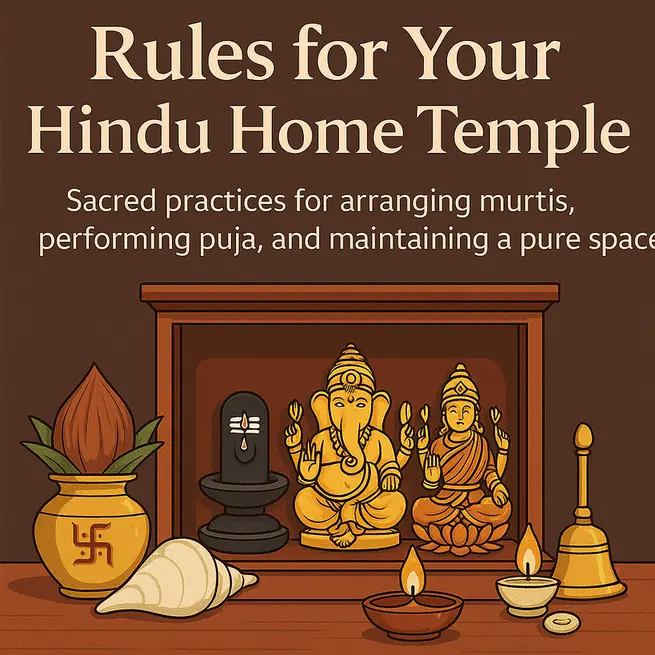The Hidden Mistakes That Block Prosperity and the Ancient Remedies That Restore Divine Energy
A home temple is not just a wooden cabinet or a shelf with idols.
It is the energetic heart of the house, the place where divine frequencies enter, settle and shape the destiny of the family.
Yet most people unknowingly keep certain murtis, objects or practices in their mandir that block fortune, disturb harmony and reduce the benefits of puja.
This blog reveals the exact do’s and don’ts of a sacred home temple, based on ancient principles and the essence of the provided discourse.
Why Many People Do Pooja but Do Not Get Results
A woman once asked the Guru:
“We do so much puja, but instead of benefits, we get losses. Why?”
The answer was simple yet profound:
Small mistakes in the temple nullify the fruits of big devotion.
These mistakes may look ordinary, but they silently create:
Financial blockage
Conflict and restlessness
Delay in success
Health issues
Lack of peace
Divine disconnection
This guide will help you cleanse your temple of these hidden mistakes and invite divine grace back into your home.
Part 1: The MOST Inauspicious Things You Must NEVER Keep in Your Home Temple
These items instantly reduce the sanctity of the mandir and must be removed immediately.
1. Keeping Multiple Ganesh Murtis (3, 5 or odd numbers)
Many people keep several Ganesh idols thinking it is auspicious. It is not.
Correct Rule:
Only one or two(If different forms) Ganesh murtis are allowed.
Never keep three or more.
Multiple Ganesh idols confuse the energetic flow and block Siddhi and Buddhi blessings.
2. Broken Rice or Old Rice Kept in Puja
Rice symbolizes purity and prosperity.
Broken, stale or old rice invites negative energy.
Rule:
Replace rice regularly. Never keep broken rice in the mandir.
3. Photos of Dead Ancestors
This is one of the biggest mistakes people make.
Pitra photos must not be placed in the temple, because:
Ancestors and Devatas have different frequencies
Mixing both causes energetic imbalance
It disturbs peace and may cause losses
Correct Placement:
Keep ancestor photos in the South zone, never in mandir.
4. Murtis of Saints, Gurus and Sadhus
Gurus are respected, but their murtis should not be placed in the dev-sthan.
You may hang their photos on walls, but separate from temple space.
5. Fierce Deities Inside Home Temple
Avoid placing the following in home mandir if you cannot perform regular puja & rituals
Bhairav Ji
Mahakali
Shanidev
These energies are powerful but require regular worships.
6. Standing Murti of Maa Lakshmi
A standing Lakshmi idol brings instability.
Only seated Lakshmi murti is auspicious.
7. Too Many Idols Together
A cluttered temple weakens the effect of puja.
Rule:
Keep minimal idols.
One form of each deity is enough.
8. Broken, Faded or Damaged Idols and Photos
Broken idols invite misfortune.
Remove immediately and immerse respectfully.
Part 2: The MOST Auspicious Things You Must Keep in Your Temple
These items bring peace, prosperity and divine blessings.
1. Swastik
The symbol of auspiciousness, success and protection.
Draw it with roli or kumkum on Kalash or temple wall.
2. Kalash (Purnakalash)
Symbol of:
Wealth
Health
Lakshmi
Life-force energy
Keep it in the mandir for stability and abundance.
3. Shankh (Conch)
One of the 14 gems of Samudra Manthan.
Benefits:
Clears negativity
Enhances prosperity
Increases divine vibrations
Blow the shankh with mantra during puja.
4. Ghanti (Bell)
The sound of a bell purifies the surroundings.
It drives away negativity and awakens divine energy.
5. Gomati Chakra and Holy Water
Keep them for:
Protection
Financial growth
Purification
Change the water regularly.
🔱 Part 3: Correct Placement of Shivling in Home Temple
Shivling should be placed only in:
North
orEast
Never in South or Southwest.
Keep it in a calm, clean place with minimal movement around it.
🌄 Part 4: Mandatory Rules You MUST Follow in Your Temple
1. Sitting Direction During Puja
Sit facing East for maximum benefit.
West is acceptable but not ideal.
2. Temple Should Not Be Near Stairs
Stairs create downward movement and disturb divine energy.
3. Height of God’s Seat
The deity’s seat must be at least 10–11 inches higher than your seating level.
Never place murtis directly on the floor.
4. Fresh Flowers Only
Never use wilted or dried flowers.
Once flowers fade, immerse or compost them immediately.
5. Temple Should Not Be in Bedroom
If unavoidable, always cover the temple with a curtain at night.
6. Never Wear Black Clothes During Puja
Black absorbs and blocks sattvic vibrations.
Use light, pure colors.
🪔 Part 5: Correct Rules for Lighting a Diya
Lighting a diya without rules cancels its divine impact.
✔️ Right Way to Light a Diya
Place diya in front of the deity
Always light it during morning and evening
Use cotton wick for ghee
Use red moli wick for oil diya
Do not light a broken diya
Do not light two diyas together in the same holder
Do not mix oil and ghee diya together
Keep ghee diya on left and oil diya on right
✔️ Direction of Diya
Never keep diya facing West
Keep wick facing East or North for best results
These rules ensure your puja brings positive results.
⚠️ Part 6: Behaviors to Avoid Near Home Temple
Some people unknowingly commit serious mistakes:
Arguing or fighting in front of temple
Sitting intimately near temple
Using temple space for daily casual activities
Temple is a space of purity.
Any disrespectful action weakens divine energy and brings obstacles.
✨ Final Shilaavinyaas Essence
A clean mandir is a doorway to divine blessings.
A cluttered or wrongly arranged mandir becomes a barrier to prosperity.
Just by correcting your temple, your destiny can take a new direction.**
May your home be filled with purity, peace and the presence of Devtas.
Leave a comment
Your email address will not be published. Email is optional. Required fields are marked *




